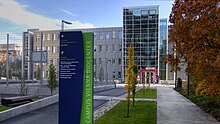Vienna Biocenter



The Vienna BioCenter is a cluster of life science research institutes and biotechnology companies located in the 3rd municipal District of Vienna, Austria. It grew around the Research Institute of Molecular Pathology (IMP), which opened in 1988. The entities at the Vienna BioCenter employ more than 2,000 people, including 600 students.[1][2]
Structure
[edit]As of 2020, the Vienna BioCenter is an association of six research entities, 38 biotech companies, 1 outreach organisation, 4 service companies and 2 business incubators.[citation needed]
There are four basic research institutes on campus: the Research Institute of Molecular Pathology (IMP), the Max Perutz Labs of the University of Vienna and Medical University of Vienna, the Institute of Molecular Biotechnology (IMBA) of the Austrian Academy of Sciences (ÖAW), and the Gregor Mendel Institute of Molecular Plant Biology (GMI), also of the ÖAW.[3] These institutes maintain a joint international PhD programme.[4] The University Biology Building (UBB) houses parts of the Faculty of Life Sciences and the Centre for Microbiology and Environmental Systems Science (CeMESS), both part of the University of Vienna.
In September 2024, the Boehringer Ingelheim Stiftung and Austrian Acaemy of Sciences (ÖAW) incepted the Aithyra Institute, a research organisation for Artificial intelligence and biomedicine.[5]
The "Vienna BioCenter Core Facilities" (VBCF) offer central services, largely scientific, but also including a child care centre.[6]
Awards
[edit]Kim Nasmyth, emeritus director of the Research Institute of Molecular Pathology (IMP), currently at the University of Oxford, received the 2018 Breakthrough Prize in Life Sciences for his work on chromosome segregation.[7][8]
After receiving the 2015 Breakthrough Prize in Life Sciences, the 2020 Nobel Prize for Chemistry was awarded to Emmanuelle Charpentier and Jennifer Doudna for their groundbreaking discoveries on the CRISPR/Cas9 system. Emmanuelle Charpentier was a principal investigator at the Max Perutz Labs at the University of Vienna from 2002 to 2009, where she laid the groundwork for developing the technology.
As of May 2021, scientists of the Vienna BioCenter institutes have been awarded 57 ERC grants and eleven Wittgenstein Awards.[9]
References
[edit]- ^ Austria, Regionalmedien (2017-07-07). "Biotechnologie: Die Zellversteher von Sankt Marx". meinbezirk.at (in German). Retrieved 2017-12-20.
- ^ Tebb, Graham (2008). "Vienna landmark". Current Biology. 18 (12). Elsevier BV: R499 – R500. doi:10.1016/j.cub.2008.06.009. ISSN 0960-9822.
- ^ "Spotlight on Austria". Nature Jobs. Springer Nature. 2014-04-23. doi:10.1038/nj0422. ISSN 1476-4687.
- ^ "PhD PROGRAMME". Vienna Biocenter PhD Programme. Retrieved 2017-12-20.
- ^ "Announcement of the inception of Aithyra Institute". Boehringer Ingelheim Stiftung. Retrieved 8 October 2024.
- ^ "VBCF | Home". vbcf.ac.at. 2017-07-07. Retrieved 2017-07-12.
- ^ "Kim Nasmyth: Glücklicher Held einer Wiener Erfolgsgeschichte". DER STANDARD (in German). 2018-02-10. Retrieved 2018-02-18.
- ^ "Breakthrough Prize awarded to Kim Nasmyth". The Research Institute of Molecular Pathology. 2017-12-04. Retrieved 2018-02-18.
- ^ Presse-Service (2017-05-03). "Archivmeldung: Angebot komplettiert: Erste Start-up Labs für Wiener Life Science-Branche". Presseservice der Stadt Wien (in German). Retrieved 2017-12-20.
